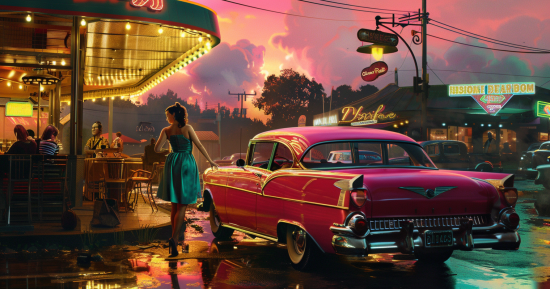Pop art, a dynamic movement born in the 1950s, captivates with its vibrant colors and bold imagery. As you explore these artworks, you’ll notice a distinct emotional tone that blends playfulness with irony.
Pop Art Images
This combination makes pop art engaging and thought-provoking, drawing you into a world where everyday objects and celebrity images take on new, often humorous meanings.
Artists like Andy Warhol and Roy Lichtenstein used popular culture motifs to create instantly recognizable pieces yet laden with deeper commentary. For instance, Warhol’s replication of consumer goods and Lichtenstein’s comic strip styles add layers of irony and parody to their works.
You’ll find that the emotional tone often shifts between light-heartedness and a more sardonic edge. This playful irony in many pop art images invites you to rethink the familiar.
The bright colors and bold lines are not just eye-catching; they’re designed to evoke specific emotional responses, making you reflect on your everyday experiences and societal norms.
Historical Context of Pop Art

Origins and Evolution
Pop Art began in the 1950s and 60s, primarily in the United States and the United Kingdom.
Artists used imagery from advertising, comic strips, and mundane cultural objects. The movement was a reaction against the abstract expressionism that preceded it. By incorporating elements of popular culture, Pop Art aimed to blur the lines between “high” art and mass production.
Techniques such as silkscreen printing allowed for mass reproduction, echoing the content they were depicting. This approach was part of a broader effort to democratize art, making it accessible and relatable to the general public.
This period also saw a significant change in the way art was consumed, with galleries and museums showcasing these works alongside traditional pieces.
Key Artists and Their Influence
Key figures like Andy Warhol and Roy Lichtenstein played pivotal roles in shaping Pop Art.
Andy Warhol’s work took ordinary consumer goods like cans of soup and transformed them into art icons. He is also known for his portraits of celebrities, commenting on fame and media.
Roy Lichtenstein focused on comic strips, emphasizing the mechanical reproduction of images. His use of Ben-Day dots and speech balloons brought a unique aesthetic, merging fine art with commercial printing techniques.
Other notable artists include Claes Oldenburg, known for his large sculptures of everyday objects, and Richard Hamilton, who is often credited with creating one of the earliest examples of Pop Art. Their collective efforts helped legitimize the movement and influenced subsequent generations of artists.
Characteristics of Pop Art

Use of Color
In Pop Art, artists frequently use bold and vibrant colors like red, yellow, and blue. These colors often grab your attention immediately, creating a striking visual impact.
For instance, Andy Warhol’s works are renowned for their bright color palettes, which evoke emotional responses and highlight the ordinary aspects of consumer products.The use of primary colors and their high contrast creates a sense of simplicity and directness.
You might notice that the colors in Pop Art mimic those in advertisements and comic books. This approach reflects everyday life and consumer culture, giving the art an accessible, familiar feel.
Additionally, these colors often carry emotional tones, such as urgency or calmness, making the artwork resonate on a deeper level.
Common Imagery and Themes
Pop Art often incorporates imagery from advertising, comic strips, and everyday consumer goods. You’ll see items like soup cans, soda bottles, and celebrities, which serve to critique or celebrate popular culture.
This imagery is used to blur the boundaries between high art and low culture, making art more inclusive.Artists such as Roy Lichtenstein and Andy Warhol utilized everyday objects and icons as focal points.
The replication of these items in art comments on society’s fascination with consumerism and mass production. Themes of irony, satire, and humor are common, inviting you to question societal norms and values.
This playful yet critical approach is signature to Pop Art, making it both thought-provoking and entertaining.
Emotional Tone in Pop Art

Irony and Satire
Pop Art engages with irony and satire to comment on mass production and consumerism.
Artists like Andy Warhol and Roy Lichtenstein employed these techniques to critique popular culture. You’ll find Warhol’s replication of everyday objects, like soup cans, both humorous and thought-provoking. It challenges how you perceive ordinary items.
Similarly, Lichtenstein’s comic strip designs use parody to create a sardonic edge that questions art and commercialism intersections.
This blend of humor and critique ensures that Pop Art maintains a playful tone while delivering its message.
Nostalgia and Sentimentality
Nostalgia and sentimentality are also significant emotional tones in Pop Art. The movement often revisits imagery from the past, evoking a sense of familiarity and comfort.
Warhol’s famous depictions of Marilyn Monroe and other celebrities tap into collective memories. These artworks offer a sentimental journey through iconic figures’ lives and times.
The use of vibrant colors and recognizable subjects creates an emotional connection, making the art deeply personal and evocative.
By drawing on these familiar elements, Pop Art captivates you with its wistful and reflective undertones.
Interpreting Pop Art

Viewer Perception
When you look at pop art, you’re often met with bold colors and familiar imagery. This combination creates a sense of immediacy and relatability.
Artists like Andy Warhol utilized repetition and bright colors to make everyday objects and celebrities stand out. These elements capture your attention and evoke a spectrum of emotions, from nostalgia to curiosity.
The use of irony and humor is another critical aspect.
Works by Roy Lichtenstein, with their comic strip styles and speech bubbles, imbue a playful tone that can make you smile or think critically about media and consumer culture.
You’re invited to see common items in a new light, challenging how you value and interpret mundane objects.
Cultural Impact
Pop art emerged as a reaction to traditional art and aimed to blur the boundaries between “high” art and “low” culture.
By incorporating popular culture elements such as advertising, comic books, and consumer goods, it reached a broader audience. This accessibility is part of what makes pop art so enduring and influential.
The cultural significance of pop art lies in its ability to reflect and critique society. Warhol’s replication of consumer goods highlighted mass production’s impact on consumer behavior.
Similarly, Lichtenstein’s comic-inspired works commented on how media shapes our understanding of emotions and relationships.
Both artists showed how art could be both a mirror and a commentator on societal norms and issues.
What mood does pop art typically convey?
Pop art often conveys a playful and ironic mood. Many artists use bright colors and familiar imagery to create a sense of fun while also critiquing everyday life and consumerism.
Which emotions are commonly expressed through pop art imagery?
Emotions in pop art range from cynicism to irony. The works of artists like Roy Lichtenstein and Andy Warhol can display a sardonic edge, often making viewers question their perceptions of popular culture.
How do pop art visuals communicate cultural relevance?
Visuals in pop art communicate cultural relevance through the use of everyday objects and celebrity images. Andy Warhol’s replication of consumer goods is a prime example of how this art form reflects and critiques contemporary society.
What are the distinguishing characteristics of pop art?
Distinguishing characteristics of pop art include bold colors, recognizable imagery, and the incorporation of mass-media elements. These features help the art stand out while making statements about modern culture.
Who is recognized as a pioneer of the pop art movement?
Andy Warhol is widely recognized as a pioneer of the pop art movement. His use of consumer goods and celebrity portraits set the tone for the genre.






